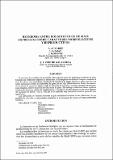Por favor, use este identificador para citar o enlazar a este item:
http://hdl.handle.net/10261/58738COMPARTIR / EXPORTAR:
 SHARE
BASE SHARE
BASE
|
|
| Visualizar otros formatos: MARC | Dublin Core | RDF | ORE | MODS | METS | DIDL | DATACITE | |

| Título: | Heterosis entre dos sintéticos de maíz expresada sobre caracteres morfológicos y reproductivos |
Otros títulos: | Heterosis in crosses between two sinthetics of corn based on morphologic and reproductive traits | Autor: | Álvarez Rodríguez, Ángel CSIC; Garay Solachi, Gotzone; Giménez, J.; Ruiz de Galarreta, José Ignacio | Palabras clave: | Maíz Variedades sintéticas Heterosis Patrones heteróticos Variabilidad Mejora genética Maize Sinthetics Heterotic patterns Variability Breeding |
Fecha de publicación: | 1993 | Editor: | Instituto Nacional de Investigaciones Agrarias (España) | Citación: | Investigación Agraria. Producción y Protección Vegetales 8 (3): 333-340 (1993) | Resumen: | [ES] Se presentan los resultados de un estudio sobre heterosis entre dos poblaciones sintéticas de maíz, formadas por poblaciones españolas y americanas. Se ha empleado un diseño de bloques completos al azar, dos años y tres repeticiones, estudiando 16 caracteres de planta, mazorca y grano. En la F1 de ambas poblaciones destaca el rendimiento de grano con un 34 p. 100 de heterosis. Existe clara heterosis en alturas de marzorca y planta y nudo de inserción de mazorca, y en otros caracteres de mazorca, como longitud, número de granos por fila y masa de grano. Sin embargo se obtienen valores negativos en floración femenina, número de ramificaciones, y en número de filas. Destaca el alto valor negativo del encamado de planta (-10,3 p. 100) que es un resultado muy beneficioso desde el punto de vista agronómico. Los coeficientes de variación muestran la gran variabilidad existente en las poblaciones, lo que posibilita la selección en determinados caracteres en un programa de mejora con esta poblaciones sintéticas. [EN]The results of a study on heterosis between two sinthetics of corn, one based on Spanish populations and the other on American populations, are showed. Evaluation was carried out for two years with an experimental design of complete randomized blocks and three replications, using 16 plant, ear and kernel traits. Yield stands up as the higher value in heterosis (34 p. 100), in the crossing between both sinthetics. MOreover there is a clear heterosis in plant and ear height and ear node. High values in ear traits, as kernel number per row and kernel weight, are also obtained. However negative values in silking, tassel branches and ear traits as number of rows are obtained. There is a high outstanding of the negative value of stalk lidging which, however, is very useful from agronomic perspective. The coefficient of variation of the traits show the large variability present within populations, making possible a selection for them in a breeding program whith these sinthetic populations. |
Descripción: | 8 Pags., 3 Tabls. | URI: | http://hdl.handle.net/10261/58738 | ISSN: | 0213-5000 |
| Aparece en las colecciones: | (EEAD) Artículos |
Ficheros en este ítem:
| Fichero | Descripción | Tamaño | Formato | |
|---|---|---|---|---|
| AlvarezA_InvAgrProdProtVeg_1993.pdf | 625,11 kB | Adobe PDF |  Visualizar/Abrir |
CORE Recommender
Page view(s)
270
checked on 21-abr-2024
Download(s)
199
checked on 21-abr-2024
Google ScholarTM
Check
NOTA: Los ítems de Digital.CSIC están protegidos por copyright, con todos los derechos reservados, a menos que se indique lo contrario.
